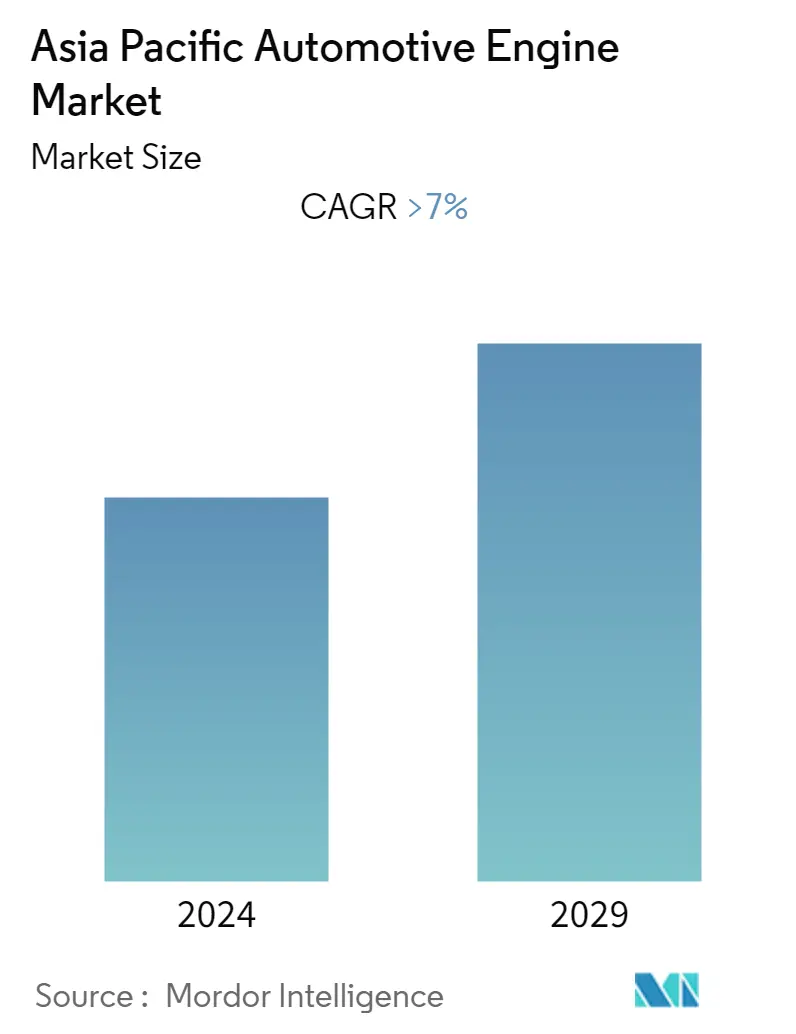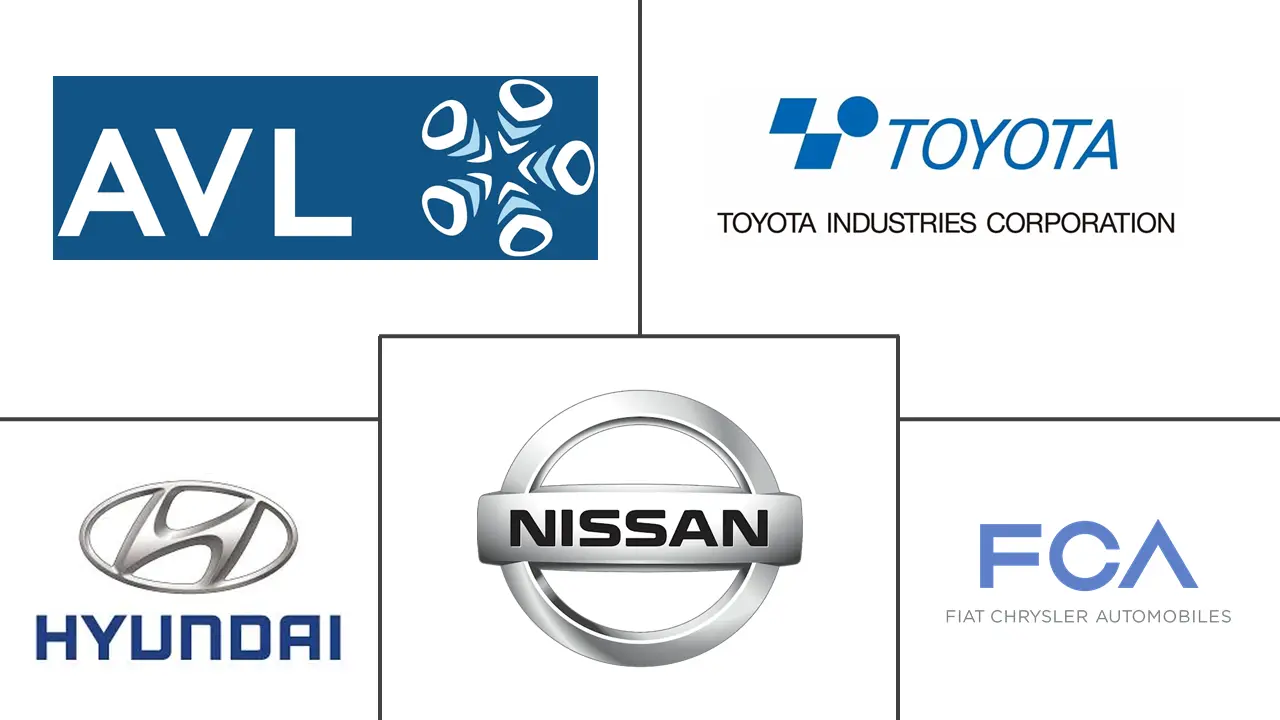Market Size of Asia Pacific Automotive Engine Industry

| Study Period | 2019 - 2029 |
| Base Year For Estimation | 2023 |
| Forecast Data Period | 2024 - 2029 |
| Historical Data Period | 2019 - 2022 |
| CAGR | 7.00 % |
| Market Concentration | Low |
Major Players
*Disclaimer: Major Players sorted in no particular order |
APAC Automotive Engine Market Analysis
The Asia Pacific Automotive Engine Market is expected to exhibit a growth rate of over 7% during the forecast period 2020-2025.
- Extensive innovations and prototypes from major automakers and OEMs, coupled with the consumer preference for high-performance and fuel-efficient automobiles, are some of the major factors that are primarily propelling the market growth.
- OEMs will have to constantly improve and develop advanced IC engines (variable valve timing and alternative powertrain). Engine downsizing and turbocharging trend is on rise with automakers developing smaller engines with better fuel injection systems. Downsizing shifts the engine operation to high loads where high engine efficiency exists. Due to lighter weights, these engines improve fuel consumption.
- Disposable income in Asia Pacific region and other developing economies is rising. In developed economies such as Norway, majority of customers have already switched to electric vehicles. This is because availability of proper charging infrastructure in these countries. Demand for electric vehicles is rising in developing countries owing to their cost efficiency and improved mobility range but due to high cost and lack of charging infrastructure that supports e-mobility, sale of IC engine vehicles happening without much hinderance.
- Automotive emission has been creating environmental concerns among consumers and governments and international environmental organizations. This, in turn, resulted in the enactment of stringent emission regulations. In India, BS4 norms were introduced in 2010 in Delhi and 13 other major cities. These norms were implemented throughout India in phases in 2015, 2016 for 2 wheelers and were mandated in the whole country from 1st April 2017. Now government requires vehicles to be equipped with engines complying BS 6 norms. Such stringent emission norms are putting cost pressures on OEMs and forcing automakers to develop better automobiles with lesser emission and better fuel efficiency and to invest in electric vehicles.
- Automotive laws and regulations in various countries are also hampering the market growth for automotive engines. In Beijing, if a customer wants to buy an IC engine vehicle, he/she must enter a lottery where they can wait up to 2 years to get a license plate.
APAC Automotive Engine Industry Segmentation
The Asia Pacific automotive engine market covers the latest trends and technological development in the automotive engine market, demand of the placement type, fuel type, vehicle type, countries and market share of major automotive engine manufacturers across the Asia Pacific Region.
| Placement | |
| In-Line Engine | |
| V-Type Engine |
| Vehicle Type | |
| Passenger Cars | |
| Commercial Vehicles |
| Fuel | |
| Gasoline | |
| Diesel |
| Asia-Pacific | |
| China | |
| India | |
| Japan | |
| South Korea | |
| Rest of Asia-Pacific |
Asia Pacific Automotive Engine Market Size Summary
The Asia Pacific automotive engine market is poised for significant growth, driven by innovations from major automakers and a consumer shift towards high-performance, fuel-efficient vehicles. The trend of engine downsizing and turbocharging is gaining momentum, as manufacturers develop smaller engines with advanced fuel injection systems to enhance efficiency and reduce fuel consumption. Despite the rising demand for electric vehicles, particularly in developed regions with robust charging infrastructure, the internal combustion engine (ICE) market remains strong in developing countries due to cost considerations and limited e-mobility infrastructure. However, stringent emission regulations and environmental concerns are pushing OEMs to invest in cleaner technologies and electric vehicles, adding pressure to maintain competitiveness in the market.
The market landscape is characterized by a mix of challenges and opportunities, with rising disposable incomes and improving road infrastructure in developing economies like India and China driving demand for passenger cars and commercial vehicles. The engine after-sale market is also expected to grow, fueled by customer-specific customization and the expanding used car market. However, the market faces hurdles such as regulatory constraints, declining vehicle sales in major economies, and the impact of shared mobility and the COVID-19 pandemic. Despite these challenges, the region's automotive engine market remains fragmented, with key players like Toyota, Honda, and Hyundai introducing technologically advanced products to capture market share.
Asia Pacific Automotive Engine Market Size - Table of Contents
-
1. MARKET DYNAMICS
-
1.1 Market Drivers
-
1.2 Market Restraints
-
1.3 Industry Attractiveness - Porter's Five Forces Analysis
-
1.3.1 Threat of New Entrants
-
1.3.2 Bargaining Power of Buyers/Consumers
-
1.3.3 Bargaining Power of Suppliers
-
1.3.4 Threat of Substitute Products
-
1.3.5 Intensity of Competitive Rivalry
-
-
-
2. MARKET SEGMENTATION
-
2.1 Placement
-
2.1.1 In-Line Engine
-
2.1.2 V-Type Engine
-
-
2.2 Vehicle Type
-
2.2.1 Passenger Cars
-
2.2.2 Commercial Vehicles
-
-
2.3 Fuel
-
2.3.1 Gasoline
-
2.3.2 Diesel
-
-
2.4 Asia-Pacific
-
2.4.1 China
-
2.4.2 India
-
2.4.3 Japan
-
2.4.4 South Korea
-
2.4.5 Rest of Asia-Pacific
-
-
Asia Pacific Automotive Engine Market Size FAQs
What is the current Asia Pacific Automotive Engine Market size?
The Asia Pacific Automotive Engine Market is projected to register a CAGR of greater than 7% during the forecast period (2024-2029)
Who are the key players in Asia Pacific Automotive Engine Market?
Toyota Industries Corporation, AVL, Hyundai Motor Group, Fiat Chrysler Automotive Group and Nissan Motor Corporation are the major companies operating in the Asia Pacific Automotive Engine Market.

